EXCLUSIVE: SpaceX Dragon Splashdown Pic!
Thursday, May 31st, 2012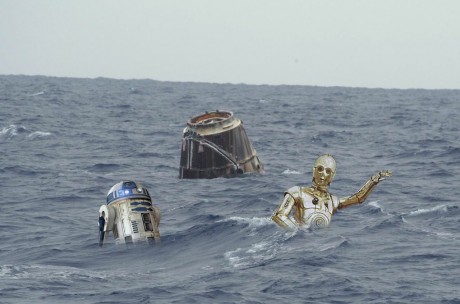
Now we know what secret cargo SpaceX had included…

Now we know what secret cargo SpaceX had included…
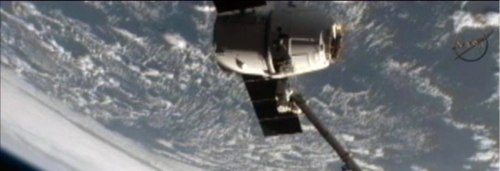
Nothing kicks off a summer of fun like the first commercial space craft hitting the waves. Minutes ago, SpaceX’s Dragon Capsule splashed down in the Pacific Ocean, ending a historic trip from GD space to the International Space Station.
Welcome home!
A derelict, abandoned hospital in Riyadh, Saudi Arabia has attracted hundreds of rookie ghost hunters for years.
Riyadh’s Iraq Hospital, a now abandoned building which treated Gulf War soldiers beginning in 1991 has become the focal point of young ghost hunters determined to rid the site of malevolent 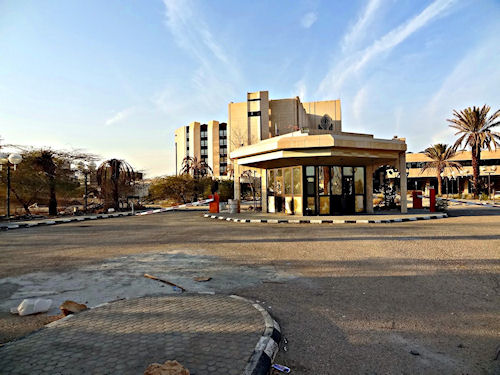 Jinn.
Jinn.
According to the Koran and Arabian mythology, Jinn are spectral beings that supposedly tempt people into doing the wrong thing.
Recently, via text messages, dozens of teen ghost hunters broke into the hospital causing massive damage to left-behind facilities before setting it ablaze in order to remove what they believed to be Jinns living within the building.
Local press complained about the unsafe condition of the building. The Healthy Ministry simply shrugged and replied that the building is on private property, cannot function as a working hospital and that it’s basically not their responsibility.
Meanwhile YouTube videos continue to surface showing young ghost hunters exploring the eerie location looking for evidence of the Jinn.
[Reuters]

It was the best of times, it was the worst of times. In a week when the boundaries of humanity’s role in space may have been redefined forever we also got the possible beginning of a zombie outbreak when a naked man was shot dead eating the face of another poor soul. Meanwhile, Andrew alerts the boys to the existence of a flesh eating bacteria that has claimed the limbs of a young Georgia woman.
Also, Justin and Brian are told of a land where dinosaurs exist. After they were built by prison labor.
Support the show by purchasing Andrew’s BRAND NEW BOOK Hollywood Pharaohs just click on the image below.

Try out the brand new PODCASTR player, featuring wireless syncing between desktop browsers and iOS devices.
Subscribe to the Weird Things podcast on iTunes
Podcast RSS feed
Episode archive
Download url: http://www.itricks.com/upload/WeirdThings053012.mp3
[podcast]http://www.itricks.com/upload/WeirdThings053012.mp3[/podcast]
Sponsored by:
• Wanderer’s Path Five free chapters available now!
Picks:
Andrew:
Brian:
Justin:
What better way to support Weird Things and get ready for Prometheus than by watching the original Alien flicks in pristine Blu-Ray quality? This collection includes all four of the series along with extensive behind the scenes features. Get it now for just $29.95
(Using this Amazon Associate link helps support Weird Things.)
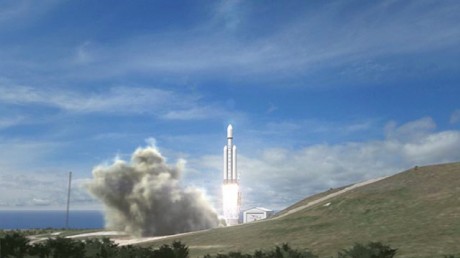
SpaceX and Intellisat, the world’s largest provider of satellite services, have issued a press release announcing that Intellisat has signed up to be the first customer for SpaceX’s next generation rocket, the Falcon Heavy. The most powerful rocket in the world (capable of delivering 117,000 pounds to low earth orbit) and the largest since the Saturn V rockets, the Falcon Heavy is expected to take flight next year.
The previous attempt at trying to build the world’s most powerful rocket was the Soviet Union’s Energia. On its first mission the rocket failed to get the payload to orbit. The second, carrying the Soviet Space Shuttle variation, the Buran, reached orbit, but actual payload capacity was a third less than the Falcon Heavy’s planned capacity.
Consisting of three modified Falcon 9 cores, the Falcon Heavy involves an innovative fuel strategy that’s never been attempted before in this kind of rocket. As the rocket gains altitude, the two outer cores will fuel the main core’s engines, so when separation occurs, the primary stage will be fully fueled and carrying no dead-weight.
Based upon proven Falcon 9 technology, the Falcon Heavy brings about radically lower launch costs of approximately $1,000 per pound, where previous cost to low earth orbit (LEO) was around $10,000 and as much as $30,000 onboard the Space Shuttle when you factor in the total program cost.
SpaceX founder Elon Musk has said a manned lunar mission on the scale of the Apollo would be capable with two launches using the Falcon Heavy. SpaceX has also proposed using a Falcon Heavy and a modified Dragon capsule to perform an unmanned Mars mission called Red Dragon, for about $450 million – oddly enough the budget and marketing cost of the film John Carter (of Mars).
While SpaceX is preparing the Falcon Heavy, engineers and scientists at their McGregor, Texas test facility will continue developing the technology for their long range plan of making a full reusable Falcon Heavy rocket by the end of this decade. Accomplishing this could bring launch costs to under $10 per pound. For more on the impact of that, check out our article Space Boom.
Andrew Mayne is a science fiction and thriller author. His website can be found at AndrewMayneBooks.com
Over the last year or so we’ve seen a lot of news about people “planking”, “owling”, “horsemanning” and the less than stellar introduction of “snailing”. What most people aren’t aware is that things like the above mentioned fads have been around for a long time.
Which brings us to “castelling”.
The word “castell’ is actually Catalan for “castle”. The concept of “castelling” began sometime in the late 1800s in Valls, Spain.
So what is “castelling”? Much like “planking” and “owling” it’s pretty self-explanatory….castles…made with people.
From Wikipedia:
A castell is considered a success when stages of its assembling and disassembling, can be done in complete succession. The assembly is complete once all castellers have climbed into their designated places, and the enxaneta climbs into place at the top and raises one hand with four fingers erect, in a gesture said to symbolize the stripes of the Catalan flag. The enxaneta then climbs down the other side of the castell, after which the remaining levels of castellers descend in highest-to-lowest order until all have reached safety.
After watching some of these tenuous “castles” collapse in on themselves?
We’re pretty sure we’re going to try to make “snailing” happen.
Very quietly and very slowly older neighborhoods and strips are making way not for new highways and public spaces but for the creeping, crawling onslaught of nature. Case in point? A small five-block neighborhood between Brooklyn and Queens that’s come to be affectionately referred to as ‘The Hole’.
Used by the mafia to dump bodies and almost completely forgotten about the busy denizens of a bustling city just blocks away, there are only a handful of people living there who continue to call it home.
Being thirty feet below sea level and part of a water basin doesn’t help either. Most of the structures are saturated with water damage from years of rains that flood the entire ‘town’.
Recently two documentary filmmakers, after learning of the location from a well-known urban explorer’s blog, visited ‘The Hole’ to tell its story and talk with the inhabitants still hanging on to their lives there.
What’s interesting is that this scene is repeating the industrial world over as yesterday’s buildings become the future’s archeological dig sites.
They’re featured in the title of practically every documentary or television show dealing with mysterious places. Their heads have adorned everything from coasters to keychains to books to backyard statuary. Heck, one of them even made it in Hollywood and nailed a part in Night at the Museum with Ben Stiller.
But now a fairly recent investigation called the EISP (Easter Island Statue Project) is uncovering something relatively new about the heads of Easter Island…they have bodies.
While experts have known about the bodies for several decades now, it’s only recently that tourists have been able to really see the dig sites up close and have seen that the enigmatic heads actually sit on shoulders of a complete figure down to the feet.
Because tourism to the islands is limited, it’s taken a while for this pictures and this information to begin circulating.
There are over 1,000 Moari heads scattered across the island and most of their bodies have simply been covered up by time.
Why is this such a big deal if experts knew about the bodies the whole time? As the bodies are excavated, petroglyphs once hidden on the statues backs and other artifacts which laid at the feet of the statues on what used to be the top layer of soil are uncovering more and more clues about the mysterious islanders who once called Easter Island home.
Across North America various species of adorable little salamanders get ‘oohs’ and ‘awwws’ get talked to like babies.
In Japan, home of fun little critters like Godzilla, things are a little different.
For a while the giant salamander population has been in a severe decline due to dams being built in their spawning path. That’s all changing as a new’ environmentally-minded generation has taken to protecting the species.
While North America does have a ‘giant’ salamander species known as the ‘hellbender’, its ‘giant’ status is misleading. At 9 inches, the North American salamander is laughable compared to its Asian cousins which can reach five feet in length and weigh in at around 80 lbs!
Not to be outdone by Germany’s cross-eyed possum, Slovakia’s two-headed turtle and the infamous Paul the Octopus, the city of Kiev is adding a pig to the psychic barnyard.
Hoping to cash in on the excitement these animals illicit from fans, this Ukranian pig will be carted out every day at four o’ clock to make its prediction about which team will be win the European championship matches leading up to the World Cup.
What’s more fascinating about whether or not the pig will accurately predict the upcoming matches, is the statement from Kiev’s city government:
“A unique oracle hog, a real Ukranian pig and a psychic which knows the mysteries of football.”
No. pressure on the pig, right?
Think again… smell that? It’s the smell of failure and delicious bacon.
If Elon Musk and MacGyver had a love child its name would be Emile LeRay.
Emile had left Morrocco and was going to drive across the Sahara in a specially prepared Citreon. His plans came to a grinding halt when he came across a military outpost that would not allow him to continue on. He was then told that he’d have to take someone (military personel) back to the nearby city of Tam Tam to ensure he followed their orders. LeRay states that a provision in his insurance doesn’t allow for him to have passengers. He turns the Citreon around and speeds off back the way he came as fast as he could get the car to go to avoid being followed by the military.
Determined to cross the Sahara, LeRay, now out of site of the outpost and the military, heads the car in large arc back toward the Sahara and around the outpost. On his way back to the road beyond the outpost, the Citreon encountered some serious terrain. Hours and miles later, the Citreon breaks down in the middle of the Sahara.
Calling upon his inner MacGyver, LeRay formulates a plan and begins breaking apart the Citreon.
Over the course of the next twelve days LeRay transforms the Citreon into a motorcycle straight from an apocalyptic future where salvaging is the new couture.
With only a small amount of water left, LeRay’s ‘Desert Camel’ (what the bike’s been nick named) sputtered to life and, after almost two weeks living in the shelled body of the Citreon, Emile continued on his adventure.
Ironically, Emile was pulled over by the military as he neared civilization.
And not for running a military outpost…
But for driving an illegal vehicle.
[Gizmodo]
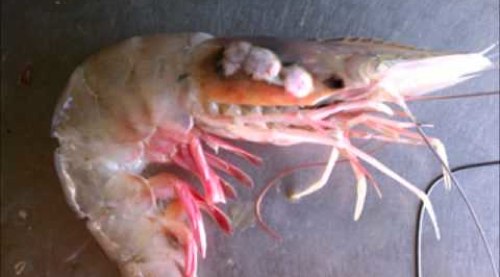
We’ve seen it time and time again in spectacularly bad science fiction grist ripe for SyFy’s cheesy flick of the week: A chemical spill causes normally docile creatures to mutate into larger-than-life versions of themselves. Sharks mix with octopi and take to land to wreak havoc amongst us soft squishy fleshlings or giant cockroaches will march on Cincinnati.
Sounds like a fun, popcorn-munchin’ night of mindless pop culture.
Too bad it’s actually happening on a small, strange scale.
Something (LSU professors are pinning the blame on the BP oil spill) is causing mutations straight out of a Roger Corman flick.
Recently the biggest piece o’ strange to get snagged in fisherman’s nets are shrimp… shrimp with no eyes or eye sockets (insert dramatic music here)!
Other fun variations on things we all know and love but that’s slowly becoming the basic building blocks of tiny nightmares are crabs with no claws, crabs encased in soft shells, shrimps with tumors on their heads, fish with no gill flaps or sealed eyes and fish with no trace that it ever had eyes at all.
What’s even more fun and waiting for a script-writer to embrace is the FDA ensuring these things are absolutely, perfectly safe for all of us to consume. That is until five years from now when we all start sprouting extra appendages and begin laying eggs to complete the birth cycle of humanity’s new masters.
[The Week]
UPDATE: It’s been determined that the ‘Causeway Cannibal’ was not on any synthetic drugs or bath salts. He was high on marijuana.
Whether we’re ready for it or not, it seems like either someone could no longer contain the T-Virus or simply that the zombie apocalypse may actually have begun….in Miami.
During a gorgeous Sunday afternoon in South Florida, a patrolling road ranger rolled up on something that can only be described as ghoulish.
Two men seemed to be scuffling on the MacArthur Causeway. What he reportedly witnessed is the kind of scene that typically begins a zombie film or opens an episode of The Walking Dead.
One of the men was naked. That same naked man was also chewing the flesh from the face from the other man.
The officer, which has not been identified as of this posting, repeatedly asked the assailant to cease his attack to no avail. Witnesses report at least a half dozen shots were fired by the officer before the attacker stopped his assault.
At the time of this posting the attack is still being investigated. The Miami Herald, which had its own surveillance cameras on a nearby parking garage has submitted the footage to the police. The victim is currently in critical condition.
While most of the news stories coming out about the incident point toward some kind of drug trip gone ugly, putting together a couple shovels, a shotgun and getting in some jogging might not be such bad idea either.
You know…just in case.

By the end of this decade we could well be on our way to the largest period of growth in human history. The global economy would dramatically increase and the overall wealth of the planet will skyrocket. The people at the lowest end of the economy will see the largest changes as they go from subsistence living to a modern middle class lifestyle made possible by this leap.
This future could be wildly off target, or it could be happening right now on a launchpad outside of McGregor, Texas. The key to this rapid growth is a simple idea. Impractical, some say impossible, it’s considered by some as far fetched as free energy or transmuting lead into gold.
But it’s not an idea that violates any laws of physics; only what we’ve done before. For a generation that’s seen the world wired electronically, watched room sized-computers shrink to devices that fit on your wrist and place face to face video calls around the planet for free, it’s a hurdle like any other, one that will take smarts, perseverance and a willingness to ignore the naysayers and do what hasn’t been done before.
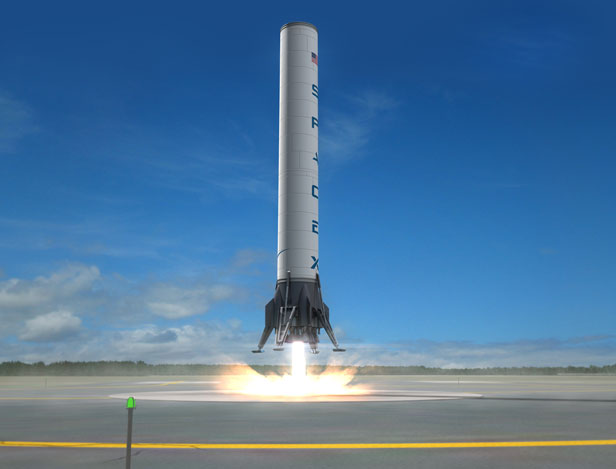
The reusable rocket
It’s a term we’ve heard before. The Space Shuttle was initially touted as ‘reusable’, when in fact only parts of it were. The large tank, the solid rocket boosters, the components responsible for most of the heavy lifting aside from the shuttle’s engines, were either burned up in the atmosphere or dropped into the ocean where salt water could corrode the parts that weren’t damaged on impact. At a $1.5 billion per launch, the shuttle hardly met the economics of reusable. It’s true cost per pound to orbit was $28,000.
A truly reusable rocket, like the kind Elon Musk and SpaceX is trying to build, can be used a 1,000 times or more. The main expense is fuel. Giving that a Falcon 9 uses only about $200,000 of fuel per launch (versus the $260,000 it costs to send a 737 around the world), expensing that capital cost over 1,000 launches ($60 million a rocket), gives you a capital expenditure of just $60,000 per launch. Round that up to $300,000 and your cost to orbit is under $15 per pound. That’s 2,000 times less than the cost on the shuttle.
In the economics of space travel, $1,000 per pound to low earth orbit was long considered the magic number where incredible economic opportunities become possible. If Elon Musk has his way and makes his even larger rocket, the Falcon Heavy, reusable, we’ll be looking at $10 per pound – less than it costs to send something cross country via FedEx.
It’s crazy. It’s insane. It’s foolish talk. And yet the world just watched astronauts on the International Space Station set foot aboard a spaceship (the first private spacecraft ever) built by people everyone was calling crazy, insane and foolish.
Now they want to build bigger rockets and think it’s possible to bring internet-like growth to the cost of going into space. I think they’ve proved they’re serious and capable. If anyone can make it happen, it’s SpaceX.
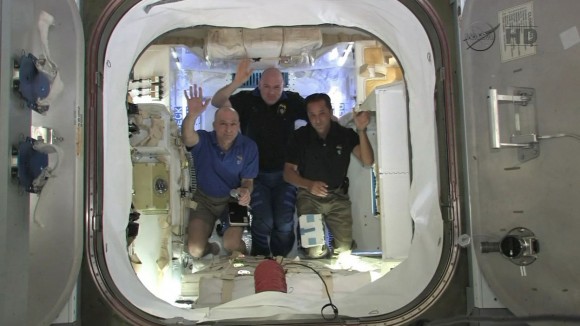
Where’s the boom?
So we can put people and satellites in space at a fraction of the cost before…what’s the big deal? What does the mean for us earthbound mortals? Everything.
Forget about space tourism, that’s low hanging fruit. In the scheme of industries, it’s only a step above renting out cabanas to cruise ship passengers. The biggest sectors of our economy aside from services and manufacturing are energy, communications and materials.
Opening up the frontier of space will change all of those radically.
First: Communications
Want more bandwidth? Want to make a clear phone call that doesn’t drop? Want to watch 4k movies on your iPhone while you’re hiking in the outback? Better yet, want the citizens of Syria and Iran to have free access to communications their governments can’t block?
Build more satellites. Lots of them. At $10 per pound, we’ll be able to blanket the planet in always-on high-speed internet access. Telecommunications companies will have to compete with underfunded rivals. Two girls in a garage could re-invent communications.
High school kids can build a communications satellite today. Unfortunately you can’t get it into space on a paper route budget (firstly, because newspapers are extinct). At a cost rivalling FedEx rates, this becomes a reality.
As bandwidth grows, so will our demand for more of it. Most of the planet is still waiting for smartphones with mere Edge-like speeds. The first-world will find all sorts of ways to push the bandwidth limits and keep the communications industry a high-profit business. We won’t be afraid to turn our phones on when we travel to other countries and will find ways to justify more bandwidth.
Second: Materials
If the dreamers at Planetary Resources have it right and some of those near earth asteroids are filled with rare metals, we could be facing an unheard of age of abundance. While finding gold in large quantities would seem like the goal, the real purpose of this mineral exploration is to find the kind of metals that have a far greater practical value than serving as bling.
The platinum group metals Planetary Resources think may abound on asteroids are some of the most import and rare kinds of materials we use in building everything from fuel cells to solar panels. Chief among them: Platinum.
Platinum costs about $1,500 per ounce. It’s the most expensive part of a fuel cell. The reason electric cars are so expensive? The battery. An abundance of platinum group metals could reduce the cost to a few cents on the dollar.
Cheap platinum would radically change the way we consume energy. Instead of getting your power off the grid, you’d plug into a fuel cell in your garage that you recycled every few months or so. For the part of the world that doesn’t have much of a grid, this is a life-changing possibility. Simple things like cheap air-conditioning could save millions of lives a year from malaria.
Third: Energy
Forget covering Arizona with solar cells. Let’s build an armada of them in space. A solar collector in earth orbit has sunlight 24 hours a day, never has to worry about clouds and runs at 144% efficiency compared to being on earth.
This would be the cleanest form of energy on or off our world.
At $10 per pound to orbit, it’s actually cheaper than what it costs to build on earth when you factor in all the ancillary costs from land leases, environmental impact and legal hurdles.
Getting that power back down to earth without creating a space beam weapon that could incinerate cities will be a challenge, but one we’ve already taken steps towards solving. It could be decades before we’re getting practical amounts of power from space. Yet it takes decades now to build a nuclear power plant or erect a wind turbine.
Abundant solar power in space also means we can use it in orbit for things like cracking water (from asteroids) into hydrogen and oxygen. Going even more out there, lots of abundant energy could one day lead to a practical means for producing antimatter – the most efficient means of containing energy and the kind of power that could take you to the other planets in days, not months and years.
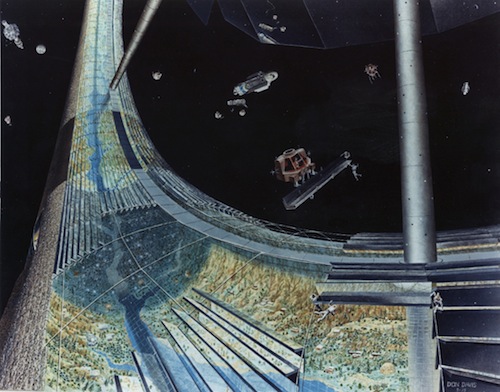
The long boom
As manufacturing moves more to rapid prototyping-style machines and becomes more of a commodity with falling prices, outside the service industry; communications, raw materials and energy are the largest parts of the global economy (agriculture is less than 4%).
To launch and service all those satellites, solar stations and asteroid mining ships, we’ll need a whole new industry. While robotics will do a lot of that work, you still need humans doing quality control and the jobs we don’t have machines for just yet.
We’ll see new companies based on doing things like providing logistics support to all these different industries, building replacement parts in orbit, training spaceworkers and a thousand other things that go with a boom.
Cheap access to space also means huge space stations, space yachts, space mansions and a whole lot of things you can do in space we never imagined on earth.
Earth orbit is just the start, but even before we set foot on Mars, there’s an entire space industry waiting to happen that goes way beyond novelty vacations for the mega-rich. We’ll thrive as an interplanetary species when exploiting the resources of space is a practical way of surviving.
The only practical limit is the number of people we can train in high-tech jobs to make this possible. To solve this problem, smart people need to be having more kids and we need to find ways to help the rest of the planet get access to better educational resources.
The near future
The exciting part is that we could know within just a few years, maybe before even before we see book five of Game of Thrones on television (or the third film in the new Spider-Man series shows on screens) if this is possible.
As we speak, a group of SpaceX engineers are in Texas test firing rockets, examining landing systems and checking off days on their calendar, bringing us closer to finding out if this is a pipe dream that’s still decades away, or something that will become a reality very soon.
This final photo is their reusable test rocket on the launch pad at their test facility in Texas. See that little line to the right? That’s the SpaceX Dragon and the ISS in orbit overhead.
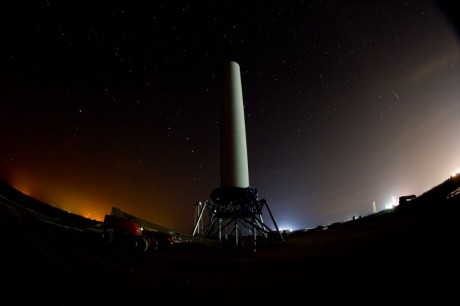
It’s one thing to dream about the stars, it’s another to go to work and look up and see where you’ve been and know where you’re going next.
Andrew Mayne is a science fiction and thriller author. His website can be found at AndrewMayneBooks.com
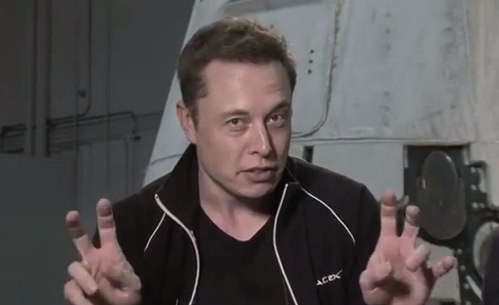
A fun moment from yesterday’s press briefing about SpaceX’s Dragon spacecraft docking with the International Space Station, marking the first time a commercial craft has done any such thing. Ever.
Anyhow, Musk was asked to explain some of the complications his team experienced while approaching the station. He took it upon himself to describe the issue in a format many laymen will understand… as Dr. Evil from the Austin Powers franchise.
Skip to 24:20 in the embed below or click here to get there on YouTube.
[YouTube]